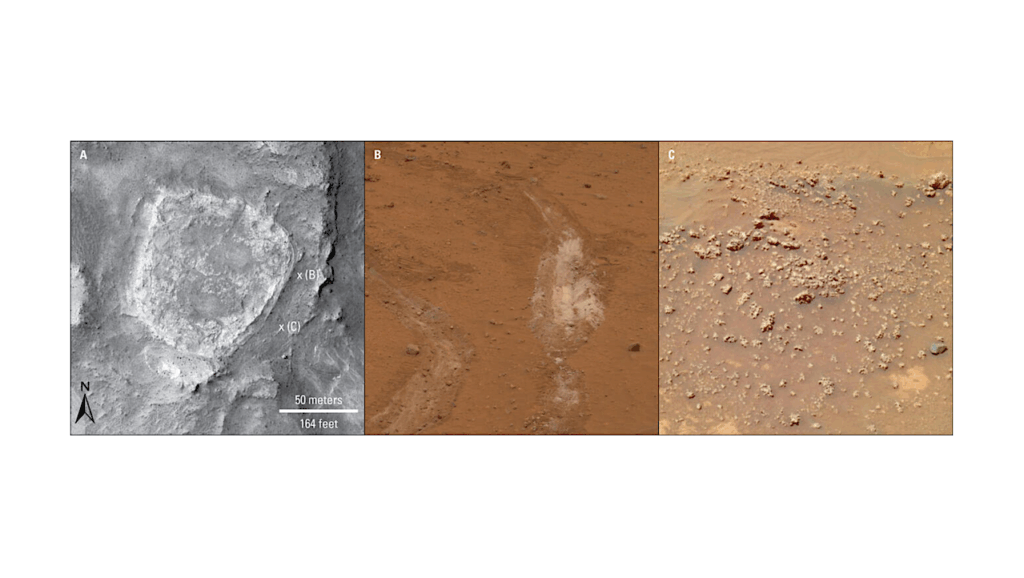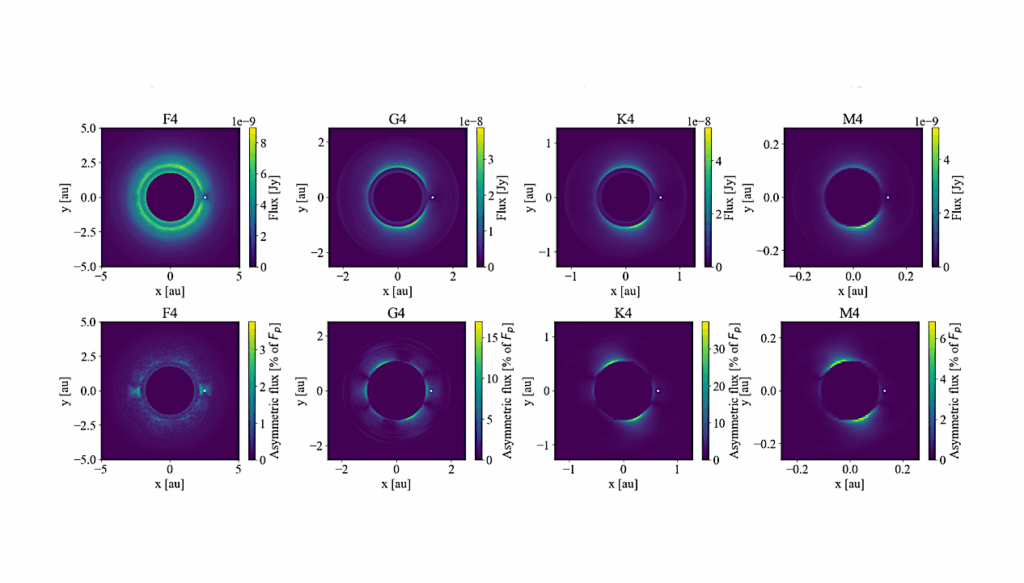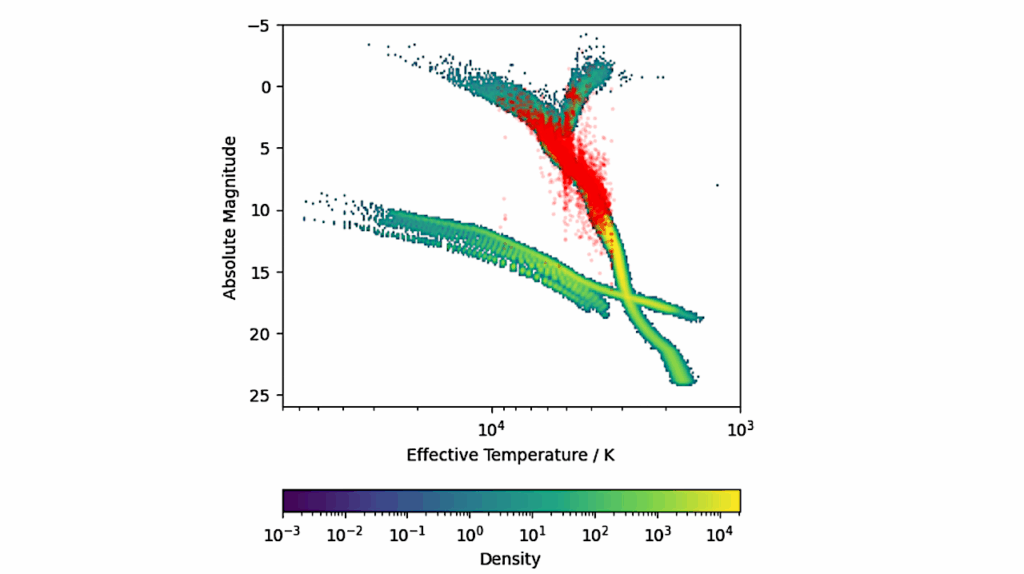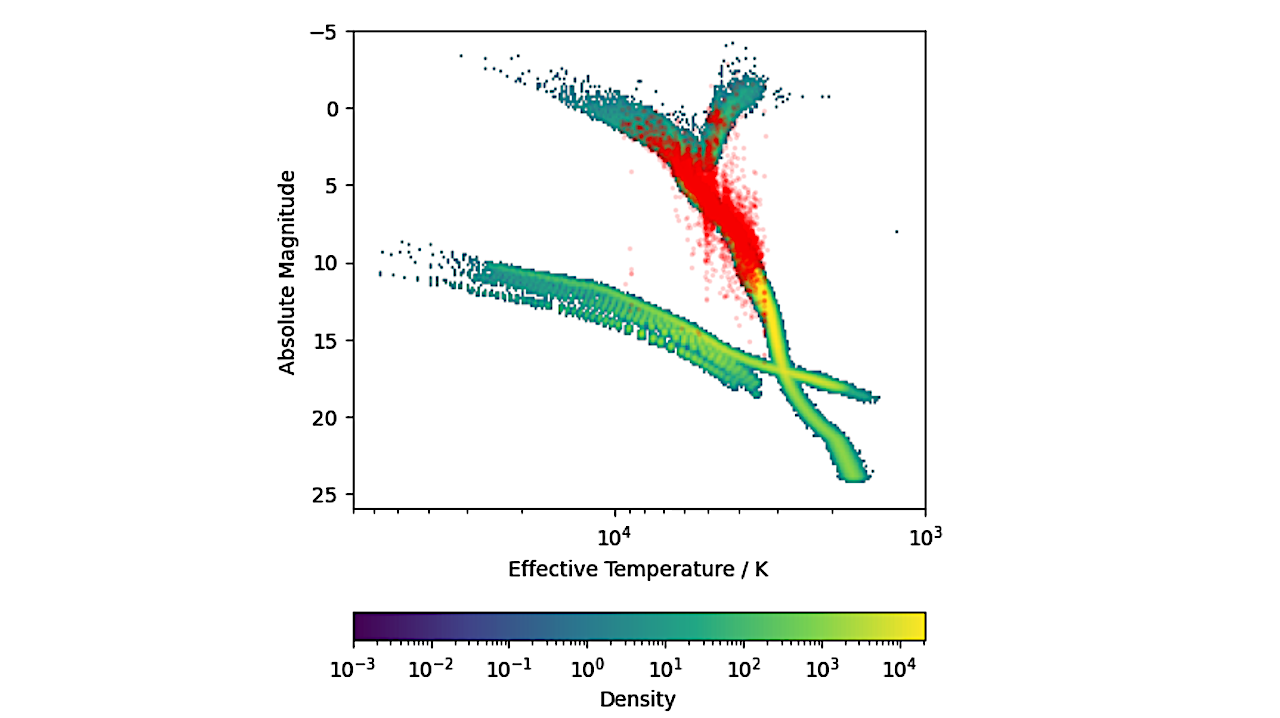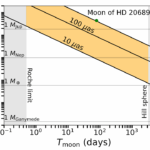Now Reading: Exomoon Search With VLTI/GRAVITY Around The Substellar Companion HD 206893 B
-
01
Exomoon Search With VLTI/GRAVITY Around The Substellar Companion HD 206893 B
Exomoon Search With VLTI/GRAVITY Around The Substellar Companion HD 206893 B
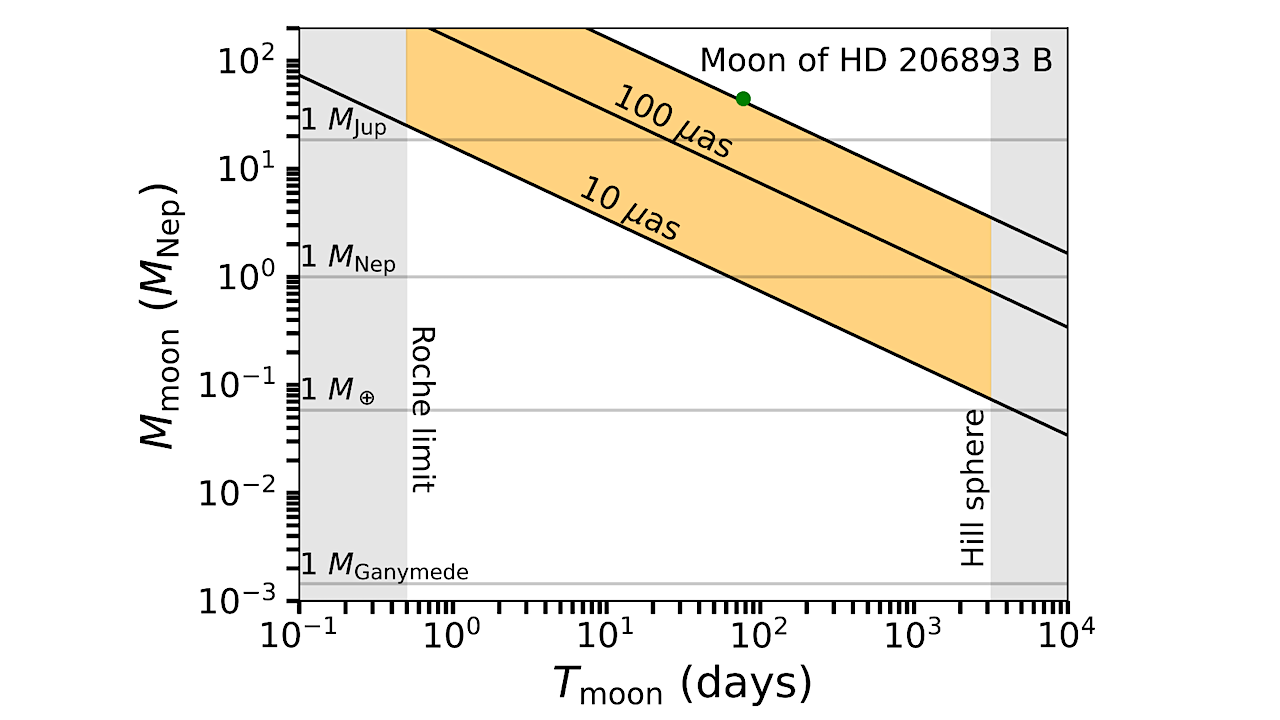
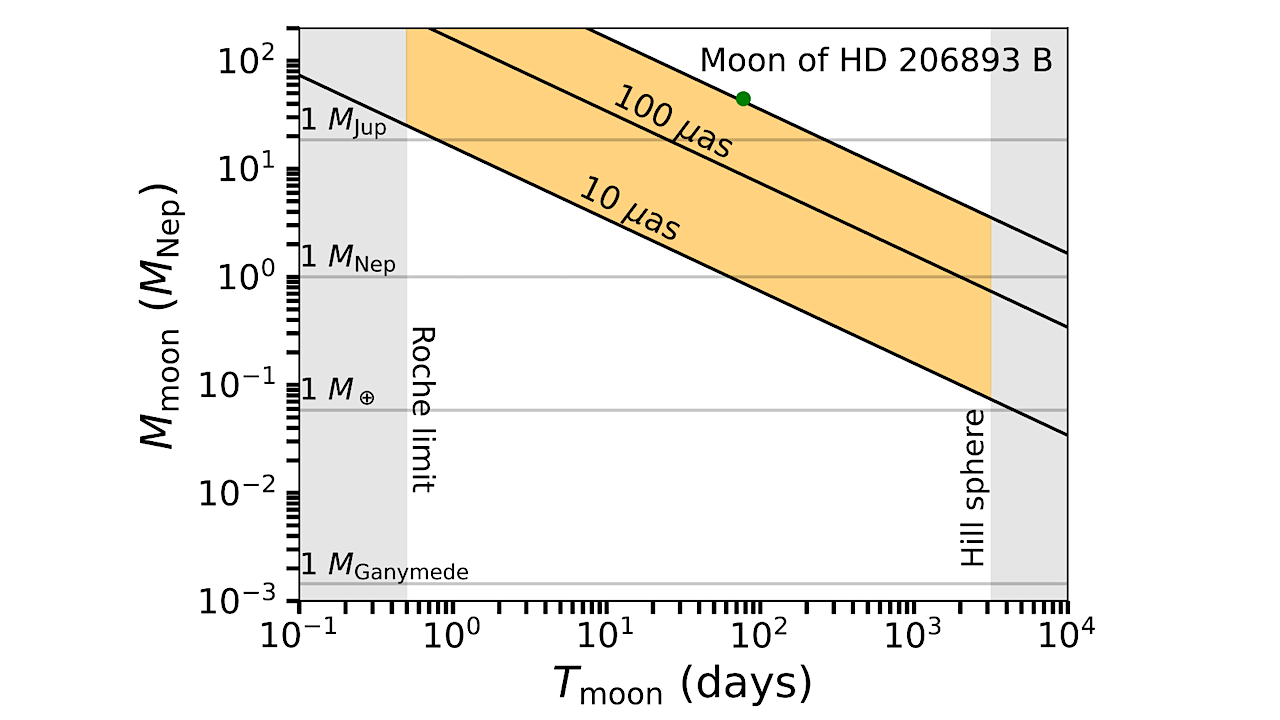
Analytical predictions for the astrometric effect of a moon with varying mass and distance to HD 206893 B. GRAVITY could in principle detect moons lower than a Neptune mass at larger periods. The fit of the GRAVITY data is shown as a green point assuming the mass and period as upper limits in our tentative detection. The orange area shows the plausible parameter space where a moon could be located, and still be potentially detectable with GRAVITY assuming an astrometric accuracy of 10 µas (see section 3.3). — astro-ph.EP
Direct astrometric detection of exomoons remains unexplored. This study presents the first application of high-precision astrometry to search for exomoons around substellar companions.
We investigate whether the orbital motion of the companion HD 206893 B exhibits astrometric residuals consistent with the gravitational influence of an exomoon or binary planet. Using the VLTI/GRAVITY instrument, we monitored the astrometric positions of HD 206893 B and c across both short (days to months) and long (yearly) timescales. This enabled us to isolate potential residual wobbles in the motion of component B attributable to an orbiting moon.
Our analysis reveals tentative astrometric residuals in the HD 206893 B orbit. If interpreted as an exomoon signature, these residuals correspond to a candidate (HD 206893 B I) with an orbital period of approximately 0.76 years and a mass of ∼0.4 Jupiter masses. However, the origin of these residuals remains ambiguous and could be due to systematics. Complementing the astrometry, our analysis of GRAVITY R=4000 spectroscopy for HD 206893 B confirms a clear detection of water, but no CO is found using cross-correlation.
We also find that AF Lep b, and β Pic b are the best short-term candidates to look for moons with GRAVITY+. Our observations demonstrate the transformative potential of high-precision astrometry in the search for exomoons, and proves the feasibility of the technique to detect moons with masses lower than Jupiter and potentially down to less than Neptune in optimistic cases.
Crucially, further high-precision astrometric observations with VLTI/GRAVITY are essential to verify the reality and nature of this signal and attempt this technique on a variety of planetary systems.
Q. Kral, J. Wang, J. Kammerer, S. Lacour, M. Malin, T. Winterhalder, B. Charnay, C. Perrot, P. Huet, R. Abuter, A. Amorim, W. O. Balmer, M. Benisty, J.-P. Berger, H. Beust, S. Blunt, A. Boccaletti, M. Bonnefoy, H. Bonnet, M. S. Bordoni, G. Bourdarot, W. Brandner, F. Cantalloube, P. Caselli, G. Chauvin, A. Chavez, A. Chomez, E. Choquet, V. Christiaens, Y. Clénet, V. Coudé du Foresto, A. Cridland, R. Davies, R. Dembet, J. Dexter, A. Drescher, G. Duvert, A. Eckart, F. Eisenhauer, N. M. Förster Schreiber, P. Garcia, R. Garcia Lopez, T. Gardner, E. Gendron, R. Genzel, S. Gillessen, J. H. Girard, S. Grant, X. Haubois, Th. Henning, S. Hinkley, S. Hippler, M. Houllé, Z. Hubert, L. Jocou, M. Keppler, P. Kervella, L. Kreidberg, N. T. Kurtovic, A.-M. Lagrange, V. Lapeyrère, J.-B. Le Bouquin, D. Lutz, A.-L. Maire, F. Mang, G.-D. Marleau, A. Mérand, P. Mollière, J. D. Monnier, C. Mordasini, D. Mouillet, E. Nasedkin, M. Nowak, T. Ott, G. P. P. L. Otten, C. Paladini, T. Paumard, K. Perraut, G. Perrin, O. Pfuhl, N. Pourré, L. Pueyo, D. C. Ribeiro, E. Rickman, Z. Rustamkulov, J. Shangguan, T. Shimizu, D. Sing, J. Stadler, T. Stolker, O. Straub, C. Straubmeier, E. Sturm, L. J. Tacconi, A. Vigan, F. Vincent, S. D. von Fellenberg, F. Widmann, J. Woillez, S. Yazici et al. (33 additional authors not shown)
Comments: accepted for publication in A&A
Subjects: Earth and Planetary Astrophysics (astro-ph.EP); Solar and Stellar Astrophysics (astro-ph.SR)
Cite as: arXiv:2511.20091 [astro-ph.EP] (or arXiv:2511.20091v1 [astro-ph.EP] for this version)
https://doi.org/10.48550/arXiv.2511.20091
Focus to learn more
Submission history
From: Quentin Kral
[v1] Tue, 25 Nov 2025 09:08:50 UTC (5,106 KB)
https://arxiv.org/abs/2511.20091
Astrobiology
Stay Informed With the Latest & Most Important News
Previous Post
Next Post
-
 012024 in Review: Highlights from NASA in Silicon Valley
012024 in Review: Highlights from NASA in Silicon Valley -
 02Panasonic Leica Summilux DG 15mm f/1.7 ASPH review
02Panasonic Leica Summilux DG 15mm f/1.7 ASPH review -
 03How New NASA, India Earth Satellite NISAR Will See Earth
03How New NASA, India Earth Satellite NISAR Will See Earth -
 04And Thus Begins A New Year For Life On Earth
04And Thus Begins A New Year For Life On Earth -
 05Astronomy Activation Ambassadors: A New Era
05Astronomy Activation Ambassadors: A New Era -
06SpaceX launch surge helps set new global launch record in 2024
-
 07Space Force plans new ‘Futures Command’ amid pressure to speed up modernization
07Space Force plans new ‘Futures Command’ amid pressure to speed up modernization












